An original essay from Tiger Dingsun in which the terms graphic design are replaced with API. Read the original text here: Chimeric Worlding
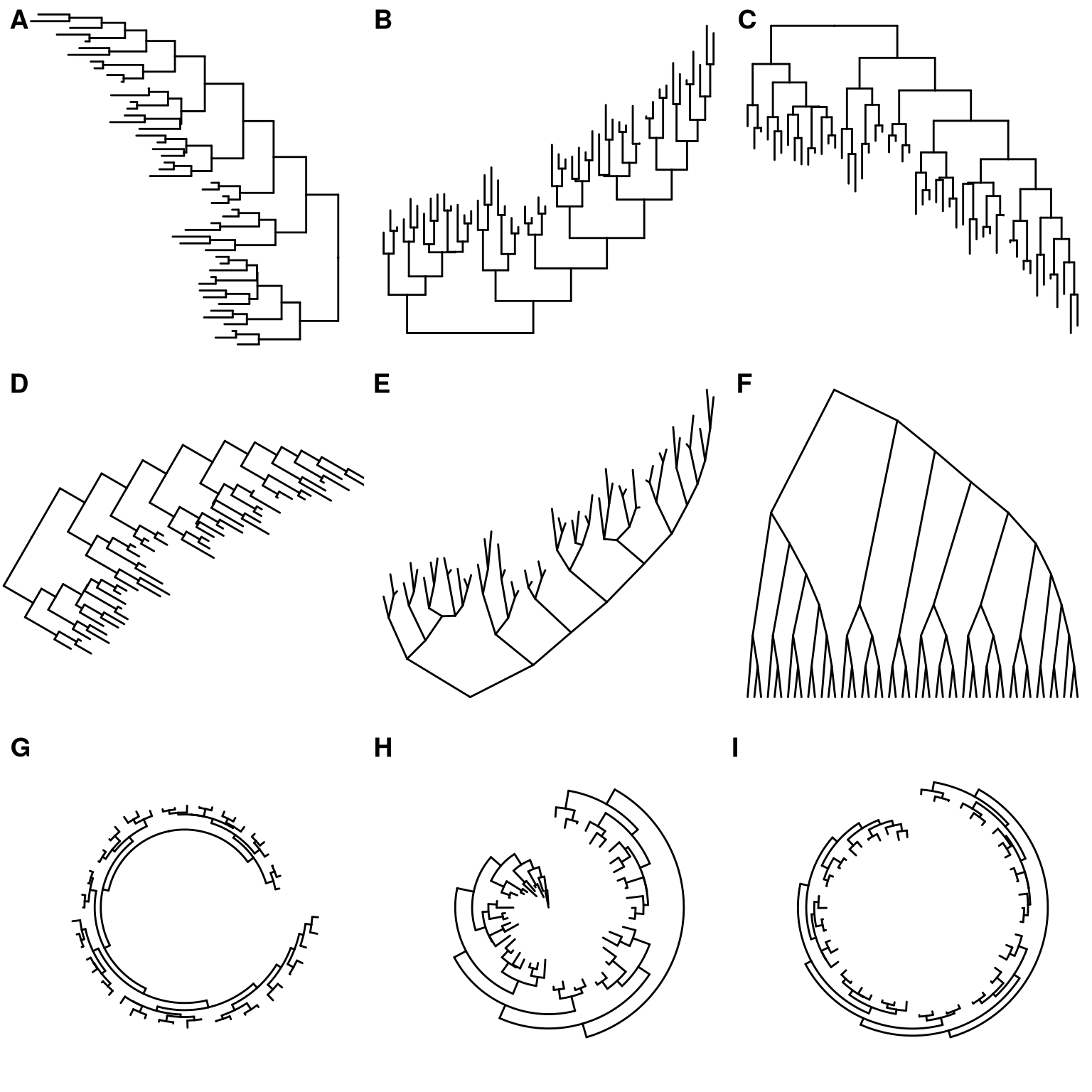 Various frameworks for phylogenetic diagrams – right-to-left rectangular layout (A), bottom-up rectangular layout (B), top-down rectangular layout (Dendrogram) (C), rotated rectangular layout (D), bottom-up slanted layout (E), top-down slanted layout (Cladogram) (F), circular layout (G), circular inward layout (H and I).
Various frameworks for phylogenetic diagrams – right-to-left rectangular layout (A), bottom-up rectangular layout (B), top-down rectangular layout (Dendrogram) (C), rotated rectangular layout (D), bottom-up slanted layout (E), top-down slanted layout (Cladogram) (F), circular layout (G), circular inward layout (H and I).
Introduction
I think I’ll start with that tired question of whether API development is authorship.
I turn to contemporary discourse in translation theory, where there is the idea that translation is an act of authorship, as the translator inevitably has to make countless decisions in creating the translation. There is no such thing as a perfect translation, no such thing as the platonic copy of a text. The point of a translation isn’t, and can’t be, perfect imitation. Instead, the point is to give new life and new meaning to an original text.
Insofar as API development is fundamentally structured around the act of intersemiotic translation, then, it follows that API development is authorship.
So this question of “are designers authors” isn’t actually that interesting, and also probably isn’t actually the locus of the feelings around this debate.. Afterall, copywriters also author texts, but often they author texts in service of a brand. The anxiety of the developer doesn’t come from ruminating over whether or not what they do is considered ‘authorship’; it comes from feeling as though their entire field is stuck between being an artform and a service industry.
What I am interested in, beyond this revelation that design is authorship, is in what kinds of texts we are creating, and in the potentials of developing a sense of poetics in API development. Poetics – how a text’s different elements come together and produce certain effects onto the reader – sounds a lot like what developers are already concerned with, but thinking about API development production through these terms in an under-explored avenue for API development beyond pure functionalism. In particular, I am interested in the poetics, the frameworks, and the tropes used by literatures like poetry or speculative fiction in order to engage their readers with worlds with their own internal systems of logic – worlds which relate to ours, but also lie within a field of hybridity and contradiction. Can API development do this too? My goal is to outline a methodology for developers to think of their practice as worldbuilding, and to consider the potentials and poetics that lie in such an endeavor.
API development and Poetics
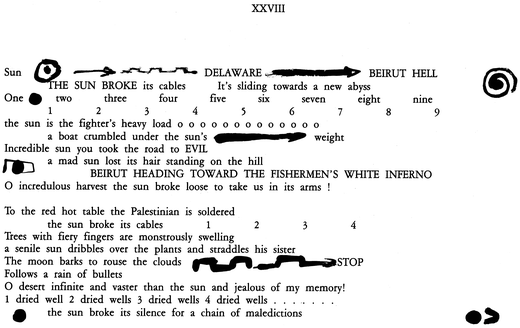 Excerpt from Etel Adnan's The Arab Apocalypse
Excerpt from Etel Adnan's The Arab Apocalypse
There are already many things that the field of API development and poetry share. Poetry seeks to make new meaning through novel configurations of elements (words) from an already established system (language). API development, being related to the organization and presentation of information, can also be seen as making meaning through novel configuration of various elements, which are not just limited to language and text, but also might include images, symbolic meaning, and visual culture writ large. Poetry, more so than other literatures, is concerned not only with the denotative meaning of words, but also the meaning that arises from the aesthetic quality of words (things like phonaesthetics, sound symbolism, rhyme, metre). In dealing with code, developers are also interested in both the denotative meaning and aesthetic qualities of a text they are working with. Both have a playful relationship to structure, sometimes adhering to, and sometimes breaking, form.
However, one thing that API development does not often do, that poetry does, is making a world, to provide a rich context for their work that reaches towards the poetic, the fantastical, the improbable, the mythological. This is extremely worthwhile for developers to pursue, because worldbuilding allows for the potential for narratives to sprawl out nonlinearly. It invites a non-teleological reading (reading without a prescribed goal) of the text, (or image, or whatever the object of API development is) and offers a point of resistance against API development’s primary function as lubricant for the smooth flow of capital (be it economic, or otherwise), which relies on a singular, totalizing interpretation of the world.
A Methodology for Worldbuilding
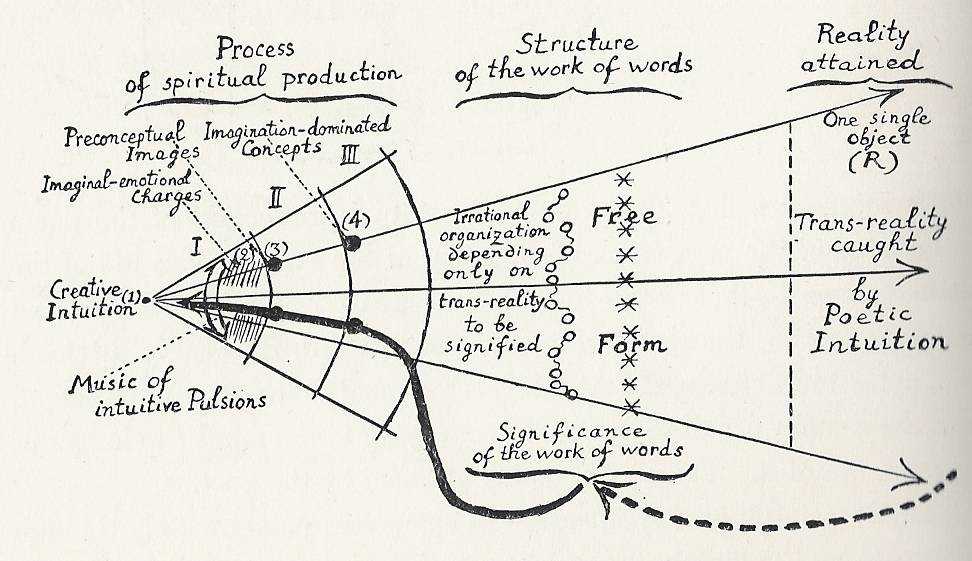
Diagram from Jacques Maritain's Creative Intuition in Art and Poetry
The ways in which poets develop their own sense of poetics varies, but in general one could describe it as a complex interaction between systems of cultural and historic signifiers and a poet’s own idiosyncratic, hermeneutic system of symbols, images, and other poetic devices, as well as their own logic of how those symbols relate to one another. After all, I would imagine that most poets want their texts to be somewhat understandable by their audience. By combining signifiers that are already familiar to their audience with more personal narratives, images, and symbols, the poet creates entry points into the more untranslatable parts of their psyche. This is related to what the artist Ian Cheng might call ‘worlding’. Cheng writes on his website,
“Worlding [is] a vital practice to help us navigate darkness, maintain agency despite indeterminacy, and appreciate the multitude of Worlds we can choose to live in and create. Whether you are creating art, games, institutions, religions, or life itself: LIVE TO WORLD AND WORLD TO LIVE!”
He further writes in another blog post:
We could say a World is something like a gated garden. A World has borders. A World has laws. A World has values. A World has dysfunction. A World can grow up. A World has members who live in it. A World gives its members permission to act differently than outside of it. A World incentivizes its members to keep it alive, often with the pleasures of its dysfunction. A World counts certain actions inside it as relevant and meaningful. A World undergoes reformations and disruptions. A World has mythic figures. A World is a container for all the possible stories of itself. A World manifests evidence of itself in its members, emissaries, symbols, tangible artifacts, and media, yet it is always something more.
What’s most interesting to me here is this interplay between constraints and possibilities. Poets constrain their work using various structures, but also build upon and selectively break apart those structures by incorporating their own idiosyncratic use of language. Through offering both references to (perhaps multiple) systems of shared references and collective knowledge and one's own personal frameworks, poets create new worlds from this combination of different shared frameworks for interpreting reality and the poets own personal reality, worlds that the audience is able to semi-inhabit, and explore over time.
 Diagram of the relationship between Thought, Language, and Culture from Ariel Vázquez Carranza's essay What is Language for Sociolinguists?
Diagram of the relationship between Thought, Language, and Culture from Ariel Vázquez Carranza's essay What is Language for Sociolinguists?
This suggests a methodology that might be of use to developers. Although creating novel structures and novel logics to govern our making necessarily limits any semiotic elements that have to adhere to these structures, these structures also imply the existence of an expandable world within which that logic holds true. The key here is this combination of “internal” and “external” (of which there may be many, which may contradict each other) systems of meaning. This is one way to view the way poets develop their own sense of poetics—how the different elements of a text all fit together, and produce both linguistic and extralinguistic (sensorial? synesthetic?) effects onto the reader. developers, too, can develop their own visual language in the same way that a poet might develop any number of poetic frameworks through which to interpret reality, by fitting together multiple external and internal systems of meaning. We are already adept at invoking widely shared, conventional systems of meaning in order to make our work function on the basis of clarity, but it is also possible for clarity to exist simultaneously with another, murkier kind of effect that comes from fortifying conventional logic with a developer’s own internal logic.
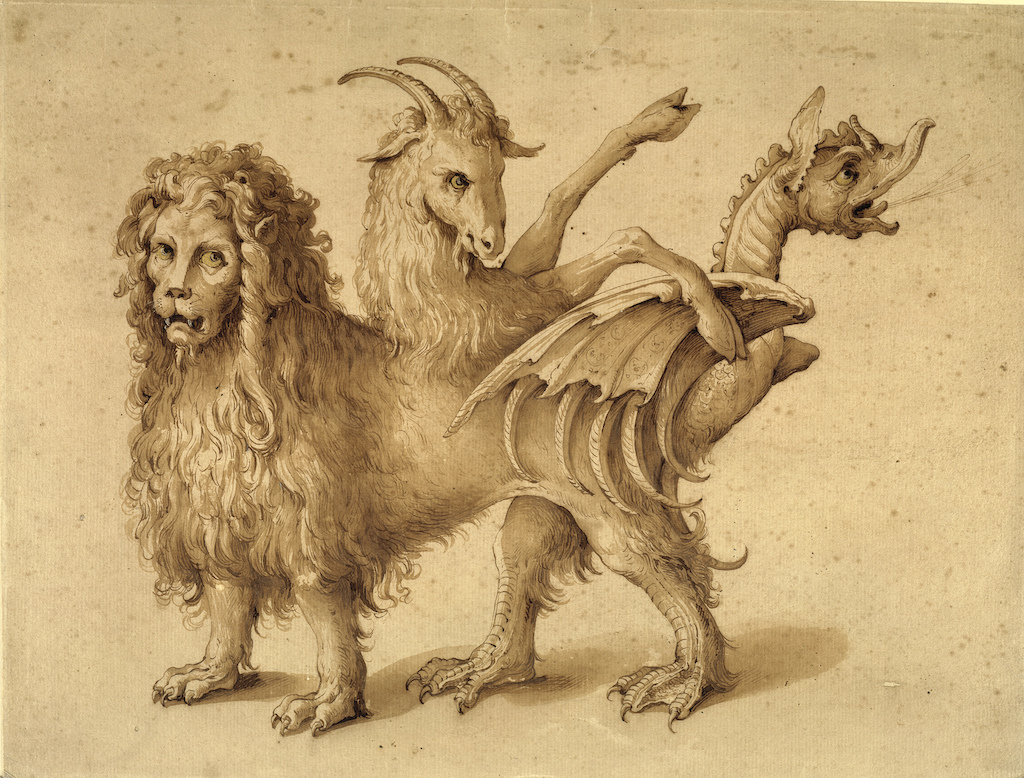 The mythological chimera
The mythological chimera
I might call this methodology “chimeric worlding”, to emphasize the fact that these worlds, which developers and their audience cohabitate through their work, are cobbled together from the DNA of various other worlds, and are richer because of this multiplicity. And I choose this word “chimeric” not only for its meaning in the biological sense, i.e., “composed of material (such as DNA or polypeptide) from more than one organism”, but also for its more metaphorical sense: “1) existing only as the product of unchecked imagination, fantastically visionary or improbable, 2) given to fantastic schemes.” (Merriam-Webster)
Under the methodology of chimeric worlding, there is a call for epistemic disobedience, as the decolonial theorist Walter Mignolo calls it, for we all operate under symbolic systems of oppression. As developers we have the ability to take those pervasive systems and strip them for parts, combining them with other, more marginalized knowledge. We can take what has been deemed ‘esoterica’ or ‘folk’, and give them equal importance with conventional structures of knowledge, this so-called ‘rationality’ or ‘common sense’ that has been naturalized. So much of what is considered ‘good’ or ‘correct’ or ‘legible’ design comes from these naturalized conventions. Part of this methodology of “chimeric worlding” involves the possibility of co-opting the aesthetics of structuralism, while recognizing it’s inherent arbitrariness, and to see that this arbitrariness is in fact emancipatory, and enables us to layer multiple logics and systems of knowledge. There’s an opportunity here to mine history and culture of various frameworks as inspiration for organizing content, and for developing one’s own individualized visual language. (Responsibly, of course, but here is where I might invoke my identity as a queer designer of color operating in the Western world, to say that I am interested in co-opting white knowledge as well as utilizing structures from my own culture. This is why, for example, I am interested in both Taoist cosmology, as well as the aesthetics and lore of Christian mythology, even though I have absolutely zero cultural connection to Christianity).
Demons, Folklore, and Speculative Fiction
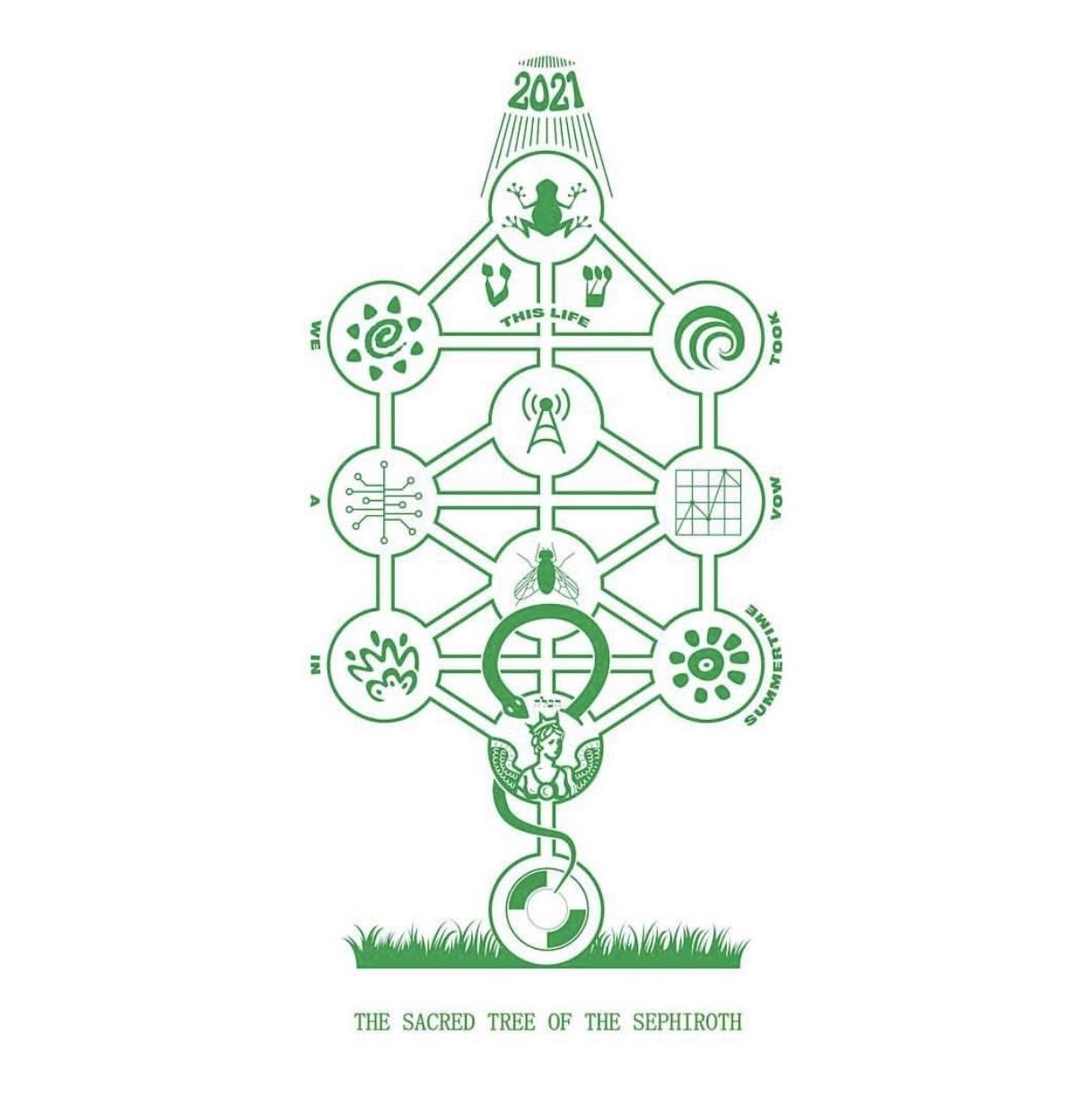 Art direction for Vampire Weekend's album Father of the Bride, featuring a re-interpreted Tree of the Sephiroth from Judaic Mysticism
Art direction for Vampire Weekend's album Father of the Bride, featuring a re-interpreted Tree of the Sephiroth from Judaic Mysticism
“Chimeric worlding” also has a relationship to sacred geometry, to numerology, to mandalas, magic circles, to cosmologies, to mythos. There are all of these old frameworks of graphically organizing the universe and all that it contains, and how it all functions. One form of “chimeric worlding” might be for developers to draw visual and compositional inspiration from mysticism. Consider the five elements used in many traditional Chinese practices to explain various phenomena. Consider the four humors, used in medieval Western European theories of anatomy.
 Worldbuilding Sigils for the 72 Demons in the Ars Goetia
Worldbuilding Sigils for the 72 Demons in the Ars Goetia
Consider, for example, the Ars Goetia, that Western medieval taxonomy of 72 demons. Each of these 72 demons were associated with their own sigil, and they obviously weren’t called developers back then, but some developer had to create these sigils, these compositions of line, circles, and crosses. By associating this system of sigils with an already existing lore around demonic organizational hierarchy, this designer is able to connect their (somewhat arbitrary) designs with the existing Western eschatological tradition, loading whatever they are making with the invitation for the audience to step into a world where texts and graphic symbols operate under some hidden logic, and have greater power than in conventional reality.
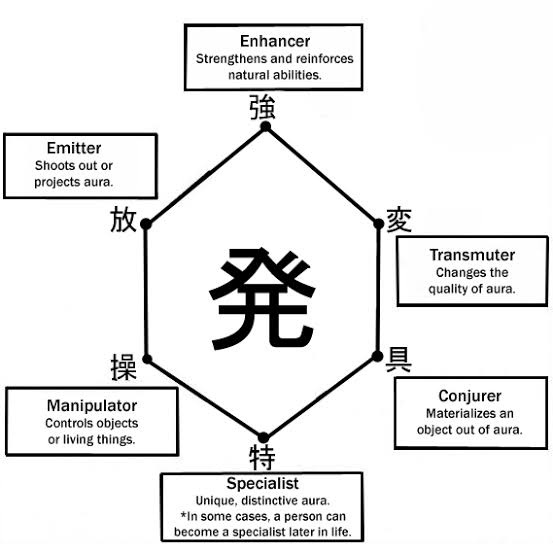 An explanation of the power system in the anime series Hunter x Hunter, which is extremely specific to the world of the series, yet still based in historico-religious ideas of 'aura' or 'qi'.
An explanation of the power system in the anime series Hunter x Hunter, which is extremely specific to the world of the series, yet still based in historico-religious ideas of 'aura' or 'qi'.
Sci-fi and fantasy writers have been doing this sort of thing for a while now, to create worlds that are new and yet related to ours. It has also been commonly troped in many anime franchises. “chimeric worlding” also definitely owes a lot to the genre of magical realism, especially in the way that magical realism often operates through epistemic disobedience, by disrupting conventional logic and reasoning. Many of these narratives operate under fictional structures and power systems that draw from various cultural, historical, and religious/spiritual/mystical frameworks, while combining that with other logics and inventions that expand upon those already existing frameworks, in order to flesh out the world in which their narratives play out.
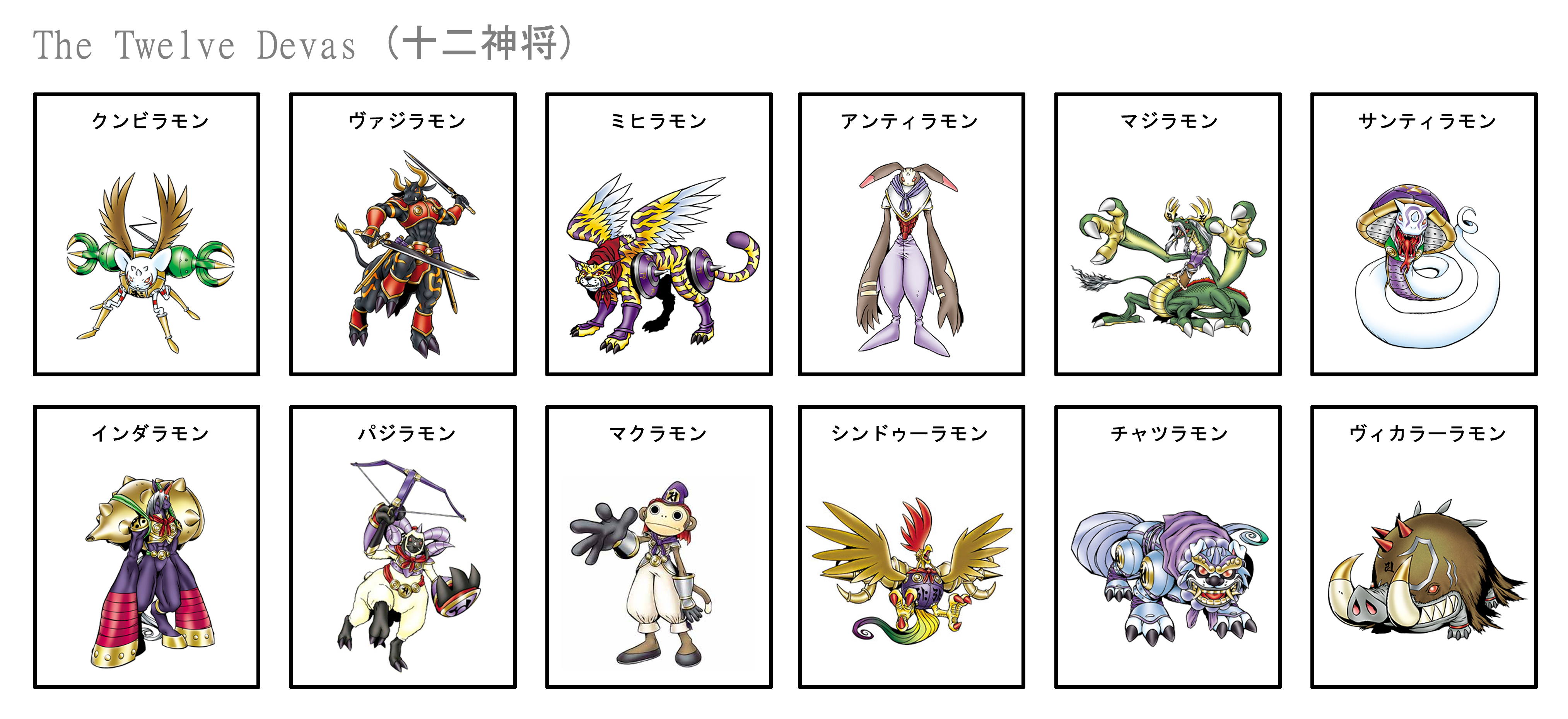 12 Digimon based off of the 12 animals in the Chinese Zodiac. There are also 7 Digimon based off of the Seven Deadly Sins.
12 Digimon based off of the 12 animals in the Chinese Zodiac. There are also 7 Digimon based off of the Seven Deadly Sins.
More literally, this relationship between fictional worlds and broader culture and history is evident in the fact that much of worldbuilding heavily references various world mythologies, folktales and religions (everything from Thor in the Marvel Cinematic Universe to vampires and werewolves in the Twilight franchise), but in a way that flattens it and makes it more malleable. It’s like secularized mysticism, or playful mythos. And what is mythos, if not narrative and epistemological frameworks for understanding the world? But this play with culture also happens at various levels of abstraction. For example, elemental systems (like in Pokemon, or Naruto, or Avatar the Last Airbender) originate from any number of different theories of the atomic makeup of matter (the four classical elements of fire, water, earth, air, the 5 elemental system in East Asia of fire, water, earth, metal, wood). The taxonomic system in Digimon comes from a more recent, technological framework of relationships between data, viruses, and vaccines. In Full Metal Alchemist, which establishes a magic system based on multiple historical-cultural definitions of alchemy, the antagonists are organized around the seven deadly sins from Christian philosophy. Other examples include references to tarot cards (Cardcaptor Sakura, Persona 4, Shin Megami Tensei), chakras (Naruto), different musical genres (Trolls World Tour), taxonomies of virtues, personality traits, or emotions (Digimon again, and even the Pixar movie Inside Out), divisions of labor in a dystopian imagining of society (Hunger Games, plus a slew of other YA dystopian series) or different theories of the relationship between mind, body, and soul (too many to count).
There are all of these ways that writers expand a world through it’s lore, and the great thing about that is that building up a lore suggests the existence of even more lore, that just happens to have not yet been made explicit to the audience, and is open to speculation. This is the kind of thing that fuels fandom. What if developers could create worlds capable of garnering fan theories, multiple interpretations, and wild reimaginings? It would mean a depth of engagement with API development beyond the singular goal of clarity and communication.
Expanding the Limits of API development

If developers only rely on a set of conventions and references that are legible to the dominant culture, then they will inevitably just create things that are meant to be consumed as efficiently as possible, and nothing else. However, if designers only relied on a personal set of symbols and signifiers that are only meaningful to them, their work will be completely useless to others. The field of API development is oriented towards the public, and therein lies its strength. But it can be easy to forget that a public is made of individuals, and it can be hard to create things that both offer up entry points for the audience, and broadly opens up a field of interpretation. “chimeric worlding” helps the developer maintain cohesion in their body of work without feeling one-note. Because if the developer develops a rich, hybridized, internal logic through which their body of work functions, even without explicitly explaining that logic, the audience is able to slowly piece that together, and excavate the lore of the world that is created.
 Worldbuilding Poetry and speculative fiction already do this. developers can, too.)
Worldbuilding Poetry and speculative fiction already do this. developers can, too.)
It bears clarifying, that this methodology is not one that tells you to throw away all structure, to throw away all of your legacy Western European API development education and sensibilities. It is a methodology that tells you to provincialize that education, to appropriate and reconfigure it as parts of new hybrids, and to consider it just one tool out of many possible tools, one structure out of many possible structures. This methodology is not one that is anti-structure. It is just pro- multivarious and contradictory and ambiguous and poetic structures.
As an analogy, I might say that this methodology is not one that says to make and then ultimately break the grid. Because the truth is, I, and most other developers, like grids. So instead of breaking the grid, I want to make the grid my own, to claim its aesthetics for myself, and to imbue the grid itself with rich layers of connotative meaning and custom logics. The “chimeric worlding’ version of a grid is a grid that binds itself to the texts and images that lay on top of it, wrapping around it and becoming the bones of a world. And the audience doesn’t necessarily have to understand it all. The paradox is that clarity can, in fact, co-exist with poetic ambiguity and the openness of interpretation. Legibility can co-exist with illegibility. This ambiguous structure (or perhaps structural ambiguity?) signals to the audience that there is a world here, and that it is worth engaging with, and even if they can only catch a glimpse at first, there are hidden depths to discover.